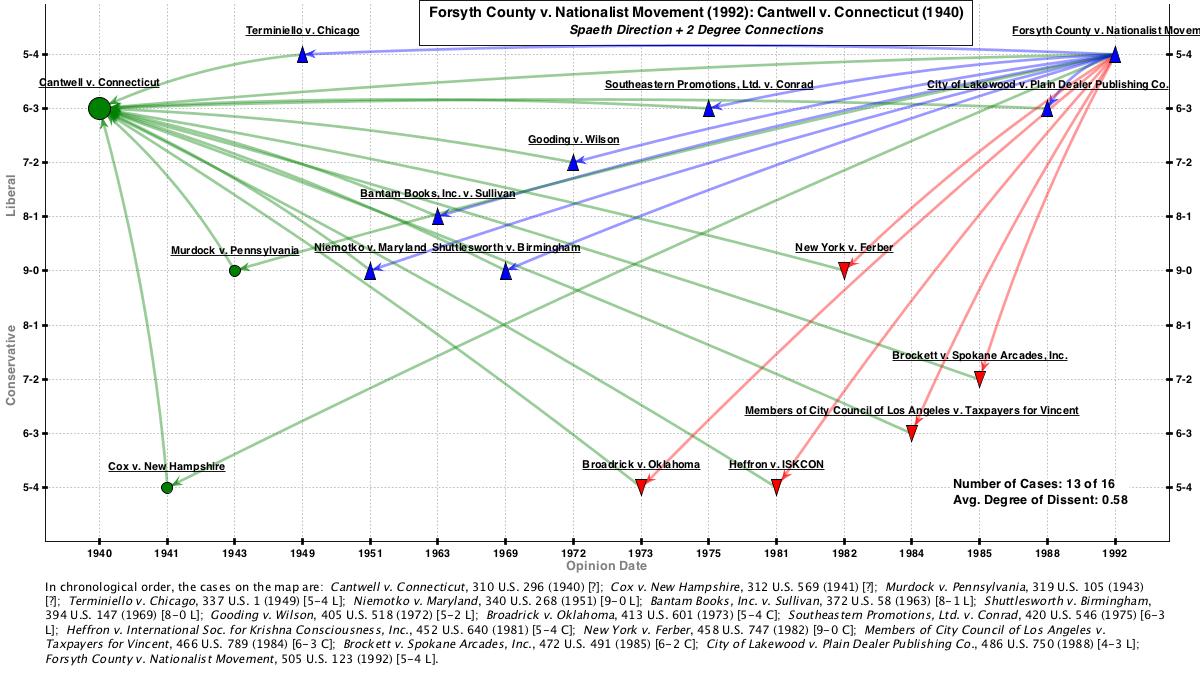Over the weekend, law student and PhD candidate Ryan Whalen posted a fascinating map of the Law Prof Twitter Network. Ryan created the map by crunching data compiled by Prof. Bridget Crawford over at the Faculty Lounge. The image is massive, striking and thoroughly fun to explore. In fact, the map provided such infectious fun that it inspired me to experiment with creating a Very Large Map of my own. Today I present the results of that experiment. It constitutes the third look in a series of three looks at Supreme Court’s fighting words/hostile audiences doctrine.
As I’ve previously discussed, I am teaching First Amendment law this semester using the Sullivan & Feldman textbook. They devote Section 3 of Chapter 1 to “Fighting Words and Hostile Audiences.” For purposes of the experiment, I consider the cases collected in this section as a “canonical.” The question for the day is: how does a network approach fare at re-creating the canonical case list?
Let’s start with the raw data. This section of the textbook has three main cases — Chaplinsky v. New Hampshire (1942), Feiner v. New York (1951), and Cohen v. California (1971). It also has eight squib cases — Gooding v. Wilson (1972), Texas v. Johnson (1989), Cantwell v. Connecticut (1940), Terminiello v. Chicago (1949), Edwards v. South Carolina (1963), Cox v. Louisiana (1965), Kunz v. New York (1951) and Forsyth County, Georgia v. Nationalist Movement (1992).
For our first look, consider the two-degree network linking the newest main case (Cohen) to the oldest main case (Chaplinsky). Using a Spaeth projection/genealogy filter, it looks like this:
As usual, blue upward-facing triangles indicate Spaeth-coded “liberal” decisions where the First Amendment “won” over state law/conviction suppressing speech. Red downward-facing triangles indicate Spaeth-coded “conservative” decisions where the First Amendment “lost.” Note that Chaplinsky is green because, like all pre-1948 cases, it does not have a Spaeth code. Since Chaplinsky upheld a conviction for speech (fighting words!), it should considered as a “conservative decision.
This map shows that the two-degree network connecting Cohen to Chaplinsky picks up the third main case in the section (Feiner) as well as three of the squibs (Terminiello, Edwards, and Cox). This is not too bad. The map also reveals that Sullivan & Feldman did not include as squibs four other cases cited by Cohen, which in turn cited Chaplinsky (Winters, Giboney, Roth and Street). Thus, we can say this simple network is both under- and over- inclusive when compared with the canonical list.
Now let’s change up the network a little. Instead of main cases (Chaplinsky and Cohen), let’s use the earliest and latest latest squibs to anchor the network. Using a Spaeth projection without a genealogy filter, this is what the two-degree network linking Forsyth County (1992) to Cantwell (1940) looks like:
 The result here is interesting. Although the Forsyth County->Cantwell two-degree network picks up more cases than the Cohen->Chaplinsky network (16 versus 10), these cases are less relevant to the canonical list. Specifically, this second network only included two additional canonical cases (Gooding and Terminiello). To me, this vindicates Sullivan & Feldman’s choice of main versus squib cases. In other words, Cohen really is more central to the doctrine at issue. The proof is that Cohen cites more cases now deemed as directly relevant.
The result here is interesting. Although the Forsyth County->Cantwell two-degree network picks up more cases than the Cohen->Chaplinsky network (16 versus 10), these cases are less relevant to the canonical list. Specifically, this second network only included two additional canonical cases (Gooding and Terminiello). To me, this vindicates Sullivan & Feldman’s choice of main versus squib cases. In other words, Cohen really is more central to the doctrine at issue. The proof is that Cohen cites more cases now deemed as directly relevant.
Finally, let’s go Very Large. This is the three-degree network connecting Forsyth County to Cantwell.
To get a better look, click on the image. Although the image is still pretty small and does not yet permit zooming in (software still in development!), you can hover your mouse over cases to see their names and even link to the underlying opinions.
The three degree network is indeed Very Large — at least from a doctrinal point of view. It contains 109 cases. Given this, it perhaps comes as no surprise that every single one of the canonical cases from Sullivan and Feldman’s list does get swept into the network. All eleven cases plus a whole lot more!
Although I confess that the main impetus for this experiment was to create a pretty picture, I do think the massive over-inclusiveness of this network is independently significant. I have an intuition that the relevant cases in a doctrinal line will almost always exist within three degrees of citation to each other. This seems to back up that intuition. Of course, I will need to do much more work to properly test this hypothesis. Perhaps the “casebook as canonical list” method explored in this post provides a potential framework to conduct a more rigorous investigation.
As always, reader thoughts are welcome!



how many audiences are there?
Excellent website. Plenty of helpful information here.
I as sure you that I’ll share this with my friends
keep posting!
Thanks for sharing your thoughts. Regards